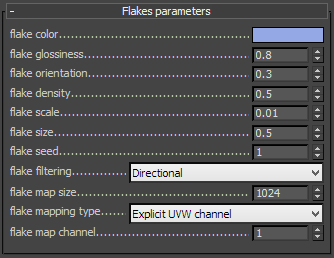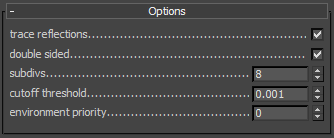VRayFlakesMtl
VRayFlakesMtl Overview
VRayFlakesMtl is a material that simulates the metallic flakes found in car paints. It is a complex material generated by the mixing of several textures and can be used in blend materials to add metallic flakes to other shaders.
Flake Layer Parameters
 Flake color
- the color of the metal flakes.
Flake color
- the color of the metal flakes.
Flake glossiness - the glossiness of the metal flakes. It is not recommended to set this above 0.9, as it may produce artifacts.
Flake orientation - controls the orientation of the flakes relative to the surface normal. When this is 0.0, all flakes are perfectly aligned with the surface. When it is 1.0, the flakes are rotated completely randomly with respect to the normal. Values above 0.5 are not recommended as they can produce artifacts.
Flake density - the density (number of flakes) for a certain area. Lower values produce less flakes, and higher values produce more flakes. Set this to 0.0 to produce a material without flakes.
Flake scale - scales the entire flake structure.
Flake size - the size of the flakes relative to the distance between them. Higher values produce bigger flakes, and lower values produce smaller flakes.
Flake seed - the random seed for the flakes. Changing this produces different flake patterns.
Flake filtering - determines the way the flakes are filtered. Filtering is extremely important to reduce the work required to produce a clean image. The possible values are:
-
Simple - this method is faster and uses less RAM but is less accurate. It averages the orientation of the flakes together, which may alter the appearance of the material when viewed from a distance.
-
Directional - this method is slightly slower and uses more RAM but is more accurate. It groups the flakes based on their orientation before performing the filtering, so that the material appearance is preserved.
Flake map size - internally the material creates several bitmaps to store the generated flakes. This parameter determines the size of the bitmaps. Lower values reduce RAM usage, but may produce noticeable tiling in the flake structure. Higher values require more RAM, but tiling is reduced. Be careful when using the Directional filtering method, as it may quickly take up gigabytes of RAM for larger map sizes.
Flake mapping type - specifies the method for mapping the flakes. The possible values are:
-
Explicit UVW channel - the flakes are mapped using the specified channel.
-
Triplanar from Object XYZ - the material automatically computes mapping coordinates in object space based on the surface normals.
Flake map channel - the mapping channel for the flakes when the Flake mapping type is set to Explicit UVW channel.
Flake trace reflections - when off, the flakes will only produce specular highlights, but no actual reflections will be traced.
Options
 Trace reflections
- when disabled, reflections from the different layers are not traced (they will only produce specular highlights).
Trace reflections
- when disabled, reflections from the different layers are not traced (they will only produce specular highlights).
Double sided - when enabled, the material is double-sided.
Subdivs - determines the amount of samples for the glossy reflections of the different layers.
Cutoff threshold - cutoff threshold for the reflections of the different layers.
Environment priority - specifies the environment priority for the environment override texture for this material. See the VRayMtl material for more information on this parameter .
Maps
This rollout contains the different texture maps for the various parameters of the material.
Notes
-
The VRayFlakesMtl material needs to precalculate several textures related to the flakes. Depending on the Flake map size parameter, this may take a few seconds. When working in the material editor, this may lead to slight delays between changing a parameter and the update of the material swatch.